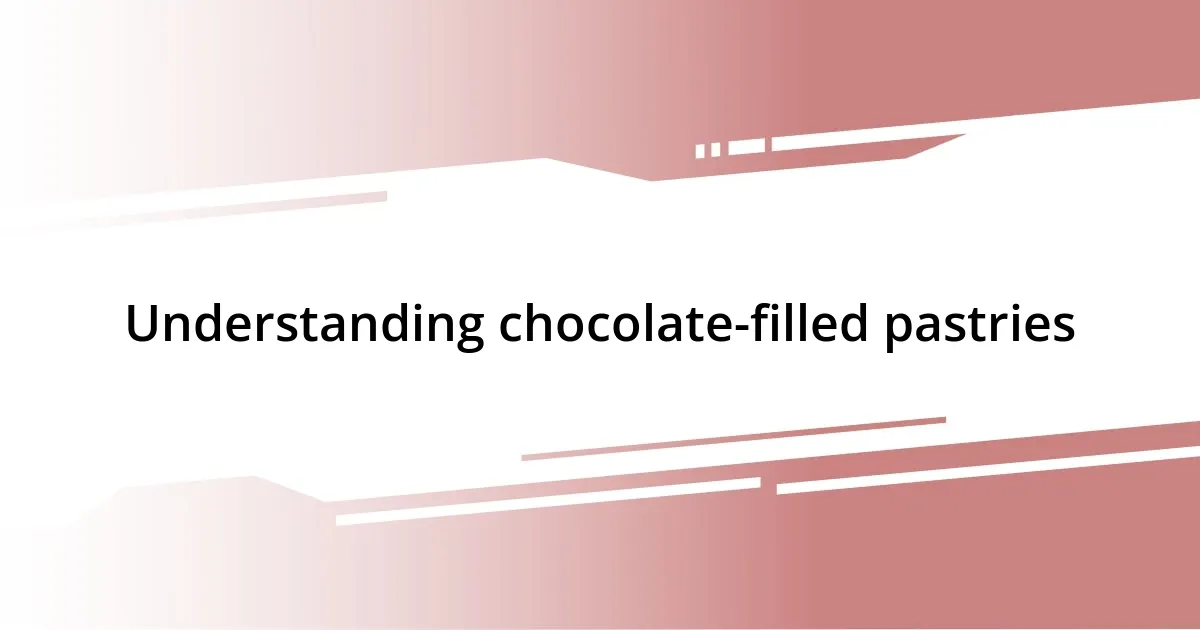Key takeaways:
- Chocolate-filled pastries blend rich flavors and textures, evoking emotional experiences with each bite.
- Choosing high-quality chocolate (70%+ cocoa) and the right dough (puff pastry or brioche) is crucial for optimal flavor and texture.
- Effective filling techniques, such as using a piping bag, enhance the overall experience and presentation of the pastries.
- Proper storage in airtight containers and serving at room temperature improves freshness and flavor, elevating enjoyment.

Understanding chocolate-filled pastries
Chocolate-filled pastries are a delightful combination of texture and flavor that can evoke a range of emotions. I still remember the first time I bit into a warm chocolate croissant— the rich, melted chocolate oozing out was nothing short of magical. Isn’t it incredible how a single pastry can transport us to a cozy café in Paris, just with one bite?
The balance of sweet chocolate and buttery dough is an art form in itself. Each pastry allows for creative variations—consider the slight bitterness of dark chocolate contrasted with the sweetness of a sugar glaze! Have you ever thought about how that balance can completely change the overall experience? It’s fascinating how different fillings, techniques, and dough types create an entirely unique treat.
When I make chocolate-filled pastries, it becomes a sensory experience. The smell of baking is a comforting embrace, and the anticipation builds as I wait for that golden crust to emerge. What’s your favorite filling? Personally, I love experimenting with spices like cinnamon or even a hint of espresso; they elevate the chocolate’s richness to another level!

Choosing the right chocolate
When it comes to choosing the right chocolate for pastries, the type you select can truly make or break the experience. I always opt for high-quality chocolate with a cocoa content of at least 70%. The deeper, more intense flavor not only enhances the pastry but also creates that delightful contrast I crave. I recall a time I used a cheaper chocolate in a batch, and while the pastries looked beautiful, the taste fell flat— it just didn’t evoke the joy I was after.
Another essential factor is the texture of the chocolate. For a smooth filling, I prefer chocolate that melts easily, like a good couverture chocolate. I once experimented with using chocolate chips, thinking the added texture would offer more variety. While they may add a bit of crunch, they often don’t melt as beautifully, resulting in a less cohesive experience. The dream is that moment when the warm pastry meets the rich, flowing chocolate— pure bliss!
I also take into account whether I want a bittersweet or creamy filling. For instance, when I make chocolate pastries for friends, I love using a mix of dark chocolate and a touch of cream. It creates this ganache that brings a luxurious feel. Have you ever tried mixing chocolates? It’s a game-changer. Experimenting with ratios can lead to delightful discoveries, and I encourage every baker to venture into this territory.
| Chocolate Type | Flavor Profile |
|---|---|
| Dark Chocolate (70%+ cocoa) | Rich, intense, slightly bitter |
| Milk Chocolate | Sweet, creamy, softer taste |
| Bittersweet Chocolate | A balance of sweetness and depth |
| White Chocolate | Creamy, sweet, no cocoa bitterness |

Selecting the perfect pastry dough
Selecting the perfect pastry dough sets the stage for your chocolate-filled creation, and I always find myself weighing my options carefully. Whether it’s puff pastry or brioche, each type offers a distinct texture and flavor experience. There was a Sunday morning when I decided to make chocolate danishes from scratch using homemade puff pastry. As I rolled out the layers, I could almost hear the dough whispering promises of flakiness and buttery richness. It’s in those moments of creation that anticipation builds—a promise of delectable pastries just moments away.
When it comes to the dough, consider these key factors:
- Type of Dough: Puff pastry creates a delicate, flaky texture, while brioche offers a rich, soft bite.
- Butter Quality: The higher the fat content, the flakier and more flavorful the dough—always choose a good quality butter.
- Ease of Preparation: Some doughs require more time and skill, so think about what suits your baking style best.
- Freshness: Freshly made dough can lead to superior flavor and texture, giving your pastries that extra ‘wow’ factor.
Selecting the dough is more than just a technical choice; it’s about crafting a moment of joy wrapped in layers of flavor. I sometimes reflect on each pastry I create, knowing it’s not just about the chocolate inside, but also the experience that unfolds with each bite. The right dough can elevate even the simplest chocolate filling into an extraordinary delicacy that lingers in your memory.

Techniques for filling pastries
When it comes to filling pastries, I like to think of it as an art form. I start by using a piping bag to inject the chocolate directly into the pastry. This technique ensures that the filling is evenly distributed, creating that delightful burst of chocolate goodness with every bite. There’s something so satisfying about that moment—when I squeeze the bag and watch the rich chocolate lavishly fill the cavity, it feels like giving the pastry a warm hug.
I also enjoy experimenting with alternate filling methods, such as layering or creating pockets. For instance, when I make cream puffs, I carefully slice the tops off to create little hats. This allows me to fill them generously and then crown them with that chocolate ganache I love. Have you ever tried this? The visual appeal combined with that feeling of decadence makes for a memorable treat. I once served these at a gathering, and they vanished in moments, leaving behind only smiles and chocolate smudges.
One technique I’ve found particularly rewarding is chilling my filled pastries before baking. This little trick helps solidify the chocolate, preventing it from bleeding out during the baking process. The anticipation while they bake is palpable—Will they puff up perfectly? Will the chocolate remain intact? I can’t help but sneak a peek through the oven door, hoping to see those golden, flaky pastries. The aroma that fills the kitchen is nothing short of magical, making it all worth the effort!

Baking tips for optimal results
When I’m preparing to bake, one of my go-to tips is to ensure all my ingredients are at room temperature before mixing. This simple step makes a world of difference, especially with butter and eggs, as it promotes better emulsification and a smoother dough. I remember the time I forgot to take the butter out in advance. The resulting dough was grainy and far from the silky texture I desired. Have you ever experienced that frustration? It’s such a small detail, yet it can truly affect the overall outcome.
Another tip that has served me well is to preheat the oven thoroughly. I like to turn it on at least 20 minutes before I start baking. This ensures that my pastries begin cooking at the right temperature from the moment they go in, promoting that beautiful rise I’m always looking for. There’s nothing quite like the moment I first open the oven door to see those perfectly puffed pastries, and I often wonder—will they achieve that golden brown hue today? Paying attention to this detail always pays off in terms of both texture and color.
Lastly, I never underestimate the power of egg wash. A light brush of beaten egg before baking can transform the appearance of my pastries. It gives them that appealing, glossy finish that makes them look bakery-fresh. I recall an occasion when I skipped this step in a rush, and while the pastries still tasted good, they simply didn’t have that enticing shine. It’s funny how such a small addition can elevate the overall presentation, isn’t it? So, if you want your chocolate-filled pastries to impress, don’t overlook the little things!

Decorating chocolate-filled pastries
Decorating chocolate-filled pastries is where I find a canvas for creativity. My favorite go-to is to drizzle melted chocolate over the top, creating a delightful artistic flair. I remember one time I got a bit carried away and ended up with a web of chocolate that looked like it belonged in a gallery. The reaction from my friends was priceless—they couldn’t wait to take a bite of what appeared to be a masterpiece!
In addition to chocolate drizzles, I love using fresh fruits or edible flowers to enhance the aesthetics. Just imagine a chocolate croissant adorned with vibrant berries! I often feel like a kid in a candy store at that moment—happy, excited, and just a bit impatient to serve it up. Have you ever seen such a pastry? The contrast of colors does wonders for the overall appeal and makes each bite even more enticing.
Sometimes, I take a more textured approach by dusting my pastries with powdered sugar or a sprinkle of sea salt. This adds not just a visual surprise but an extra layer of flavor that dances on the palate. It’s a lovely touch that brings back memories of sipping hot cocoa while watching snow fall outside. Those small details can elevate a standard chocolate-filled pastry into something truly dreamy. Isn’t it fascinating how decoration can enhance both the aesthetic and emotional experience of enjoying a pastry?

Storing and serving suggestions
When it comes to storing chocolate-filled pastries, I highly recommend placing them in an airtight container. This simple trick keeps them fresh and prevents them from becoming dry or stale. I learned this lesson the hard way during a family gathering when I left a batch out overnight, only to find them lacking that fluffy goodness the next day. Have you ever noticed the difference in texture between a fresh pastry and one that’s been exposed to air? It’s like night and day!
The temperature at which you serve these treats can also make a big difference. I find that bringing them slightly closer to room temperature enhances the chocolatey flavor. There’s something magical about savoring a warm, gooey chocolate center that sends my taste buds soaring! I often pop them in the microwave for a few seconds just before serving to recreate that fresh-out-of-the-oven experience. Have you tried that? It’s a game changer!
For an added touch of elegance when serving, consider pairing your pastries with a complementary ingredient. A scoop of vanilla ice cream or a dollop of whipped cream often elevates the experience into something truly indulgent. This brings back memories of a delightful weekend brunch I hosted where I served the pastries alongside freshly brewed coffee. Seeing the smiles on my friends’ faces reminded me why I love baking for others. What could be better than sharing joy through delicious treats?














